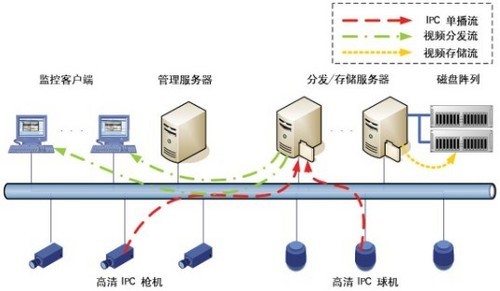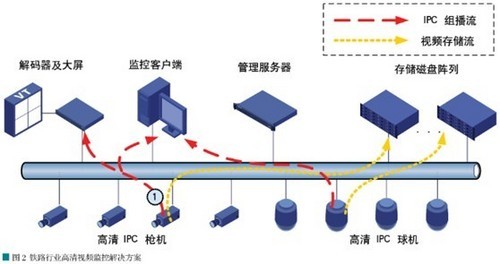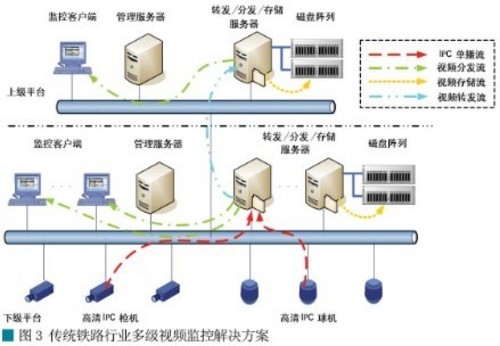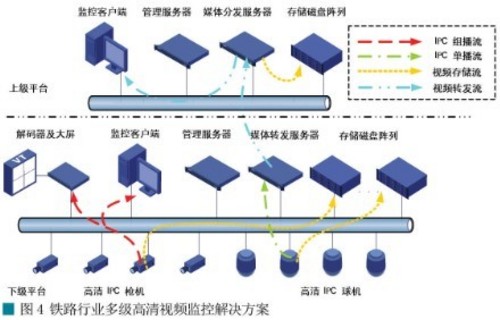Label: IPC NGN
This article refers to the address: http://
Traditional railway industry video surveillance solution
In the rail industry, HD surveillance systems bring not only clearer images and better results, but also greater system performance requirements, long-distance transmission bandwidth and storage. What kind of high-definition system can be adapted to the multi-level access, long-distance transmission, and monitoring of large-scale industry characteristics of the railway industry?
As shown in Figure 1, in the traditional railway industry video surveillance solution, the center is the streaming media server, which is common in the architecture of the station monitoring system. The front-end encoder or IPC output unicast stream is transmitted over the network to the distribution/storage server, and the distribution/storage server implements unicast-to-multicast, on-demand distribution, and on-demand storage. The entire data flow is shown in Figure 1. In the case of a full-standard-definition system, the solution can basically meet the needs of multi-user operation, but if this solution is applied to a high-definition system, the drawbacks of the streaming media distribution method will be highlighted:

Railway monitoring solution
1. The server scale increases with the increase of monitoring points, especially HD IPC wants to get better application effect. The output code stream is generally 6M-8M, which is 3-4 times of traditional SD, distribution/storage server. The number will increase dramatically, and the level of the server must be increased because the performance of the server becomes a performance bottleneck in the solution.
2. There are many local fault points in the system. When one of the distribution/storage servers fails, it will affect the storage and real-time monitoring of the multi-channel video images it manages, which is not in line with the security industry. Reliability requirements. Although this problem can be solved by redundant servers, the configuration of redundant servers at each station is rarely taken into account in practical engineering from a cost perspective.
3. The front-end IPC outputs the unicast stream, causing the storage stream and the real-time stream to occupy the same bandwidth. If the image quality is good for the high-definition system, the disk array will face greater pressure, especially the cost will be greatly improved; If the pressure of the disk is reduced, the storage stream compression ratio is increased, and the definition of the HD monitor image is greatly reduced.
4. A large number of servers and their equipment racks not only occupy a large amount of equipment space, but also do not meet the requirements of green environmental protection. More deadly is to increase the system's unreliability and increase the point of failure. When faced with emergencies and multiple hotspots, large-scale bursts of traffic can easily lead to the collapse of the entire server farm.
NGN architecture railway monitoring system solution
In Figure 2, it represents a relatively advanced video surveillance solution that uses the more mature softswitch architecture in the telecommunications field: the NGN architecture. The management server is only responsible for handling device management, signaling distribution, session establishment, and does not participate in real-time traffic (real-time streaming and storage streaming). In Figure 2, both the storage stream and the real-time stream are directly transmitted to the disk array, decoder or monitoring client through the network, thus solving the problem of the previous service performance and reliability bottleneck.
When multiple users simultaneously access the same image real-time video, support is provided through network multicast, as shown by the video stream labeled in Figure 2: the decoder and the monitoring client simultaneously access the same road image, because The front-end IPC outputs the multicast stream, and the switch in the network provides the function of code stream replication, which solves the impact of performance and bandwidth caused by large-scale simultaneous access of the front-end IPC. This solution brings many advantages in high-definition systems:

1. There is no strong correlation between the size of the monitoring points and the number of servers. The video management server only participates in the session establishment process and does not participate in the distribution of the video stream. Therefore, the system does not have a system bottleneck problem. A single video management server can meet thousands of SD and HD image monitoring.
2. Due to the adoption of the advanced softswitch NGN (service flow and control flow separation) architecture, the failure of the management server will not interrupt the monitoring of the real-time flow, and the storage flow will not be affected, ensuring that the monitoring data is still normal. The system ensures high reliability and the entire system has no local fault points.
3. The front-end IPC can output the dual code stream (storage stream and real-time stream). The two channels of video stream can separately set the code stream size, which can maximize the high-definition effect brought by high-definition monitoring, and at the same time, can significantly reduce the storage. The price is to protect the user's investment.
4. When there are emergencies or accidents and multiple hotspots occur, large-scale bursts of traffic are copied and distributed by the switch through multicast technology, thus easily solving the problem of large-scale multi-users, satisfying the public security and Enterprise management requirements for high reliability in emergency situations.
Railway multi-level video surveillance solution
The scene shown above is mainly applied to monitoring in the station, which inevitably faces the problem of remote sharing access by the superior dispatching center. The traditional streaming media distribution solution should be able to easily implement multi-level network monitoring. If only the softswitch NGN architecture is adopted, the multicast mode will encounter more troubles in the railway industry wide area network and low bandwidth. Some improvements must be made to Figure 2.
As shown in Figure 3, due to the characteristics of streaming media forwarding, the traditional solution naturally supports multiple levels of architecture. At this time, the streaming media server in the station is responsible for forwarding and storage, and is also responsible for forwarding functions, which inevitably increases the server's Performance pressure. However, this solution solves the problem that the railway WAN cannot achieve multicast and bandwidth is limited. It forwards the video image in the station to the upper-level streaming media server, and the distribution function is completed by the upper-level streaming media server, which solves the problem that multiple users simultaneously access the same road image.

Figure III
In the way of Figure 2, due to the multi-level monitoring of the railway, the network often cannot open the multicast function. If the front-end IPC unicast is directly sent to the upper-level platform, it will consume a limited WAN bandwidth and is also limited by the IPC. Distribution ability. Then, how to properly modify the mode of Figure 2 to achieve high reliability, large capacity, high performance, and at the same time adapt to the shared access of the wide area network of the railway industry?
In fact, the corresponding solution is also very simple, that is, learning from the experience of the traditional scheme, adding a media forwarding server to the monitoring platform at the station level can solve the above problem, as shown in Figure 4. However, it must be noted that the monitoring software platform at the station level must be able to support both the front-end video stream unicast and multicast modes, and the automatic unicast/multicast switching function can be implemented according to different access requirements. Such a solution can adapt to the large-scale application of the future high-definition system in the railway industry, and can ensure the efficient and reliable operation of the entire monitoring system. It is believed that the high-definition monitoring system will be widely used in the railway industry, and how to deal with the impact of the high-definition monitoring system on the existing solutions is a topic worthy of common attention.

Figure 4
NINGBO SANCO ELECTRONICS CO., LTD. , https://www.sancobuzzer.com